
Mosquitoes, the Culicidae, are a family of small flies consisting of 3,600 species. The word mosquito is Spanish and Portuguese for little fly. Mosquitoes have a slender segmented body, one pair of wings, three pairs of long hair-like legs, and specialized, highly elongated, piercing-sucking mouthparts. All mosquitoes drink nectar from flowers; females of some species have in addition adapted to drink blood. Evolutionary biologists view mosquitoes as micropredators, small animals that parasitise larger ones by drinking their blood without immediately killing them. Medical parasitologists view mosquitoes instead as vectors of disease, carrying protozoan parasites or bacterial or viral pathogens from one host to another.
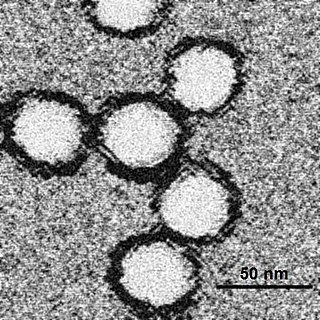
West Nile fever is an infection by the West Nile virus, which is typically spread by mosquitoes. In about 80% of infections people have few or no symptoms. About 20% of people develop a fever, headache, vomiting, or a rash. In less than 1% of people, encephalitis or meningitis occurs, with associated neck stiffness, confusion, or seizures. Recovery may take weeks to months. The risk of death among those in whom the nervous system is affected is about 10 percent.
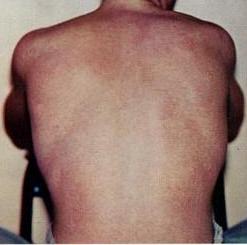
Dengue fever is a mosquito-borne disease caused by dengue virus, prevalent in tropical and subtropical areas. It is frequently asymptomatic; if symptoms appear they typically begin 3 to 14 days after infection. These may include a high fever, headache, vomiting, muscle and joint pains, and a characteristic skin itching and skin rash. Recovery generally takes two to seven days. In a small proportion of cases, the disease develops into severe dengue with bleeding, low levels of blood platelets, blood plasma leakage, and dangerously low blood pressure.

A crane fly is any member of the dipteran superfamily Tipuloidea, which contains the living families Cylindrotomidae, Limoniidae, Pediciidae and Tipulidae, as well as several extinct families. "Winter crane flies", members of the family Trichoceridae, are sufficiently different from the typical crane flies of Tipuloidea to be excluded from the superfamily Tipuloidea, and are placed as their sister group within Tipulomorpha.

Plasmodium is a genus of unicellular eukaryotes that are obligate parasites of vertebrates and insects. The life cycles of Plasmodium species involve development in a blood-feeding insect host which then injects parasites into a vertebrate host during a blood meal. Parasites grow within a vertebrate body tissue before entering the bloodstream to infect red blood cells. The ensuing destruction of host red blood cells can result in malaria. During this infection, some parasites are picked up by a blood-feeding insect, continuing the life cycle.

Aedes albopictus, from the mosquito (Culicidae) family, also known as the (Asian) tiger mosquito or forest mosquito, is a mosquito native to the tropical and subtropical areas of Southeast Asia. In the past few centuries, however, this species has spread to many countries through the transport of goods and international travel. It is characterized by the white bands on its legs and body.
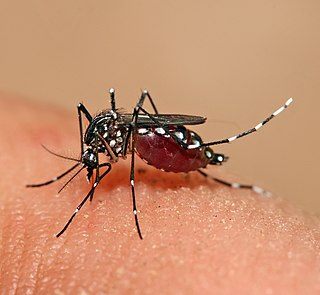
Aedes is a genus of mosquitoes originally found in tropical and subtropical zones, but now found on all continents except Antarctica. Some species have been spread by human activity: Aedes albopictus, a particularly invasive species, was spread to the Americas, including the United States, in the 1980s, by the used-tire trade.

Anopheles is a genus of mosquito first described by J. W. Meigen in 1818, and are known as nail mosquitoes and marsh mosquitoes. Many such mosquitoes are vectors of the parasite Plasmodium, a genus of protozoans that cause malaria in birds, reptiles, and mammals, including humans. The Anopheles gambiae mosquito is the best-known species of marsh mosquito that transmits the Plasmodium falciparum, which is a malarial parasite deadly to human beings; no other mosquito genus is a vector of human malaria.

Aedes aegypti, the yellow fever mosquito, is a mosquito that can spread dengue fever, chikungunya, Zika fever, Mayaro and yellow fever viruses, and other disease agents. The mosquito can be recognized by black and white markings on its legs and a marking in the form of a lyre on the upper surface of its thorax. This mosquito originated in Africa, but is now found in tropical, subtropical and temperate regions throughout the world.

Mosquito control manages the population of mosquitoes to reduce their damage to human health, economies, and enjoyment. Mosquito control is a vital public-health practice throughout the world and especially in the tropics because mosquitoes spread many diseases, such as malaria and the Zika virus.

Ceratopogonidae is a family of flies commonly known as no-see-ums, or biting midges, generally 1–3 millimetres in length. The family includes more than 5,000 species, distributed worldwide, apart from the Antarctic and the Arctic.
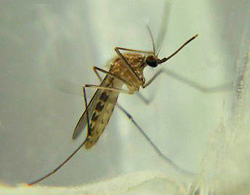
Culex or typical mosquitoes are a genus of mosquitoes, several species of which serve as vectors of one or more important diseases of birds, humans, and other animals. The diseases they vector include arbovirus infections such as West Nile virus, Japanese encephalitis, or St. Louis encephalitis, but also filariasis and avian malaria. They occur worldwide except for the extreme northern parts of the temperate zone, and are the most common form of mosquito encountered in some major U.S. cities, such as Los Angeles.
Avian malaria is a parasitic disease of birds, caused by parasite species belonging to the genera Plasmodium and Hemoproteus. The disease is transmitted by a dipteran vector including mosquitoes in the case of Plasmodium parasites and biting midges for Hemoproteus. The range of symptoms and effects of the parasite on its bird hosts is very wide, from asymptomatic cases to drastic population declines due to the disease, as is the case of the Hawaiian honeycreepers. The diversity of parasites is large, as it is estimated that there are approximately as many parasites as there are species of hosts. As research on human malaria parasites became difficult, Dr. Ross studied avian malaria parasites. Co-speciation and host switching events have contributed to the broad range of hosts that these parasites can infect, causing avian malaria to be a widespread global disease, found everywhere except Antarctica.

Culiseta is a genus of mosquitoes. Most Culiseta species are cold-adapted, and only occur in warmer climates during the colder parts of the year or at higher elevations where temperatures are lower. Species found in Southern California are larger than most mosquitoes species, specifically Cs. inornata, Cs. particeps, and Cs. incidens. These species are found throughout the year in Southern California and feed on several vertebrate species, such as birds, livestock, rodents, reptiles, and humans. The larvae of most species are found bogs, marshes, ponds, streams, ditches, and rock pools, but an African species occurs in tree holes ("phytotelmata"), a common eastern Palaearctic species occurs in water wells and rock pools, and several Australian species occur under ground. Little is known about the blood-feeding habits of females. Most species feed on birds and mammals, but a few feed on reptiles. Several species attack domestic animals and occasionally humans, and some species are pollinators.

Nepeta cataria, commonly known as catnip, catswort, catwort, and catmint, is a species of the genus Nepeta in the family Lamiaceae, native to southern and eastern Europe, the Middle East, Central Asia, parts of Mongolia, and parts of China. It is widely naturalized in northern Europe, New Zealand, and North America. The common name catmint can also refer to the genus as a whole.

Mosquito-borne diseases or mosquito-borne illnesses are diseases caused by bacteria, viruses or parasites transmitted by mosquitoes. Nearly 700 million people contract mosquito-borne illnesses each year, resulting in more than a million deaths.

Culex quinquefasciatus, commonly known as the southern house mosquito, is a medium-sized mosquito found in tropical and subtropical regions of the world. It is a vector of Wuchereria bancrofti, avian malaria, and arboviruses including St. Louis encephalitis virus, Western equine encephalitis virus, Zika virus and West Nile virus. It is taxonomically regarded as a member of the Culex pipiens species complex. Its genome was sequenced in 2010, and was shown to have 18,883 protein-coding genes.
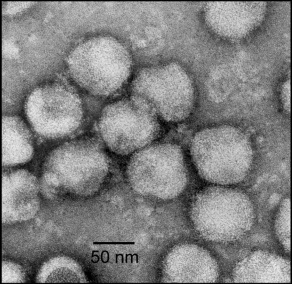
Mesoniviridae is a family of enveloped, positive-strand RNA viruses in the order Nidovirales which infect mosquitoes. The family is named after the size of the genomes relative to other nidoviruses, with meso- coming from the Greek word mesos, which means medium, and -ni being an abbreviation of nido.
Jamestown Canyon encephalitis is an infectious disease caused by the Jamestown Canyon virus, an orthobunyavirus of the California serogroup. It is mainly spread during the summer by different mosquito species in the United States and Canada.
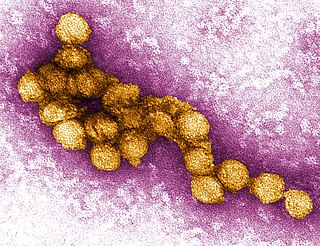
West Nile virus (WNV) is a single-stranded RNA virus that causes West Nile fever. It is a member of the family Flaviviridae, from the genus Flavivirus, which also contains the Zika virus, dengue virus, and yellow fever virus. The virus is primarily transmitted by mosquitoes, mostly species of Culex. The primary hosts of WNV are birds, so that the virus remains within a "bird–mosquito–bird" transmission cycle. The virus is genetically related to the Japanese encephalitis family of viruses. Humans and horses both exhibit disease symptoms from the virus, and symptoms rarely occur in other animals.















